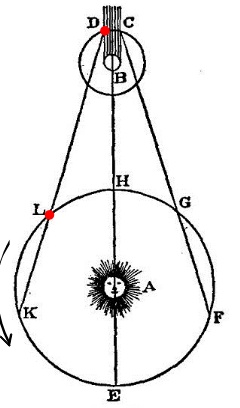Physics Notes - Herong's Tutorial Notes - v3.24, by Herong Yang
Measuring Speed of Light - Roemer's Method
This section describes the method used by Ole Roemer to measure the speed of light using changes of observed eclipse periods of Jupiter's moon.
Measuring the speed of light is not an easy job, since it moves very fast.
The earliest reasonably good measurement was done by the Danish astronomer Ole Rømer in 1676 using changes of observed eclipse periods of Io (one of the moons of Jupiter) as illustrated in the picture below.
Roemer's measurement is based on the following assumptions:
- Moon Io (represented by the red dot at D) orbits around Jupiter with a constant period of 42.5 hour.
- If we stay at a constant distance from the Jupiter, we will see Io comes out of eclipse at the same interval, 42.5 hours.
- However, Earth (represented by the red dot at L) orbits around Sun once a year.
- Because the distance between Earth and Jupiter is changing, Io eclipse interval will change.
For example, if we record the Io eclipse interval, i1, when Earth is at location L and the Io eclipse interval, i2, when Earth is at location K, the speed of light will be the distance between L and K divided by (i2-i1).
Using this method, Roemer was able to measure the speed of light as 220,000,000 m/s. Today, we know the speed of light is 299,792,458 m/s.

Table of Contents
Introduction of Frame of Reference
Different Speeds Observed in Different Frames
►Measuring Speed of Light - Roemer's Method
Measuring Speed of Light - Fizeau's Method
Measuring Speed of Light - Foucault's Method
Introduction of Special Relativity
Time Dilation in Special Relativity
Length Contraction in Special Relativity
The Relativity of Simultaneity
Minkowski Spacetime and Diagrams
Introduction of Generalized Coordinates